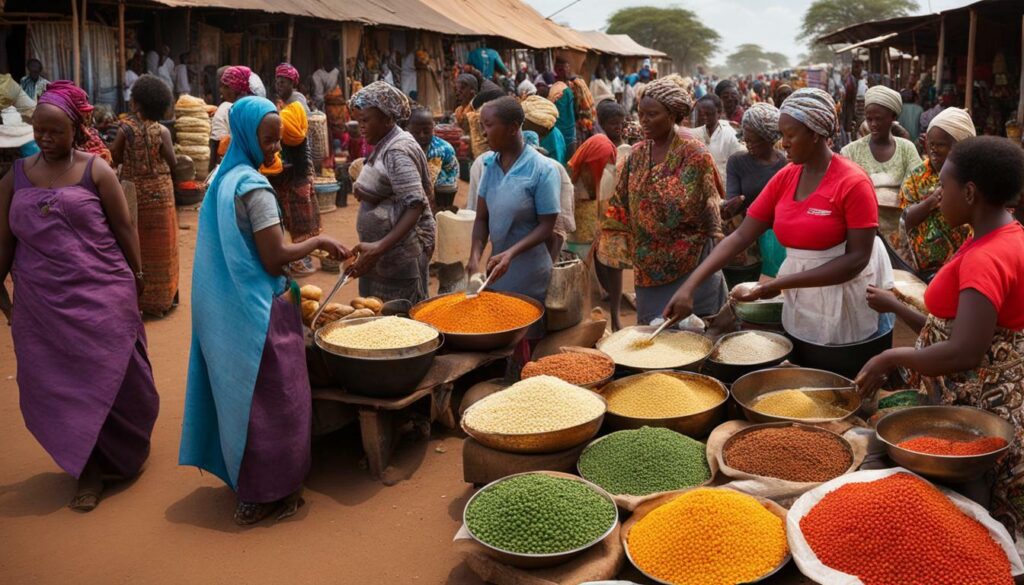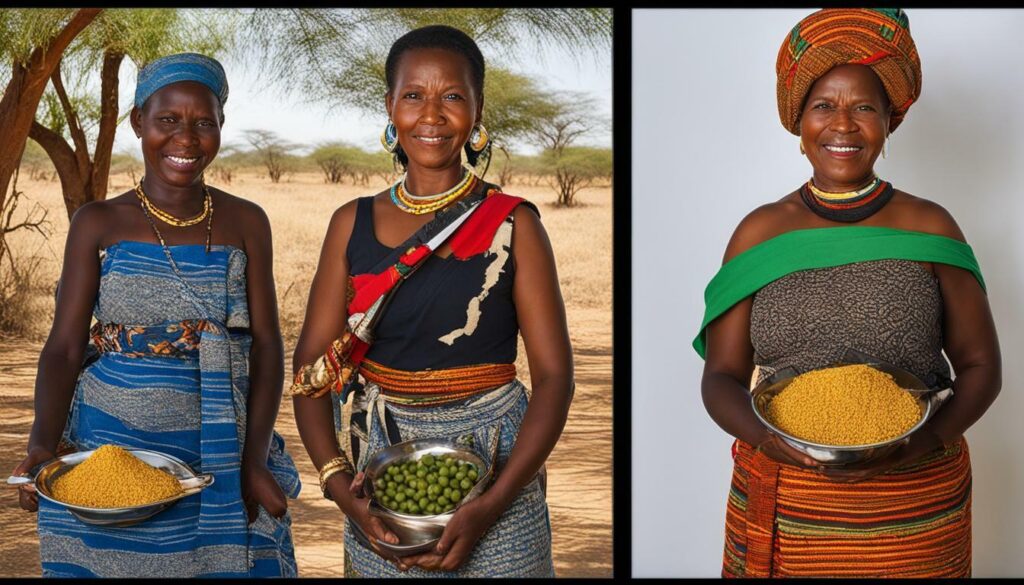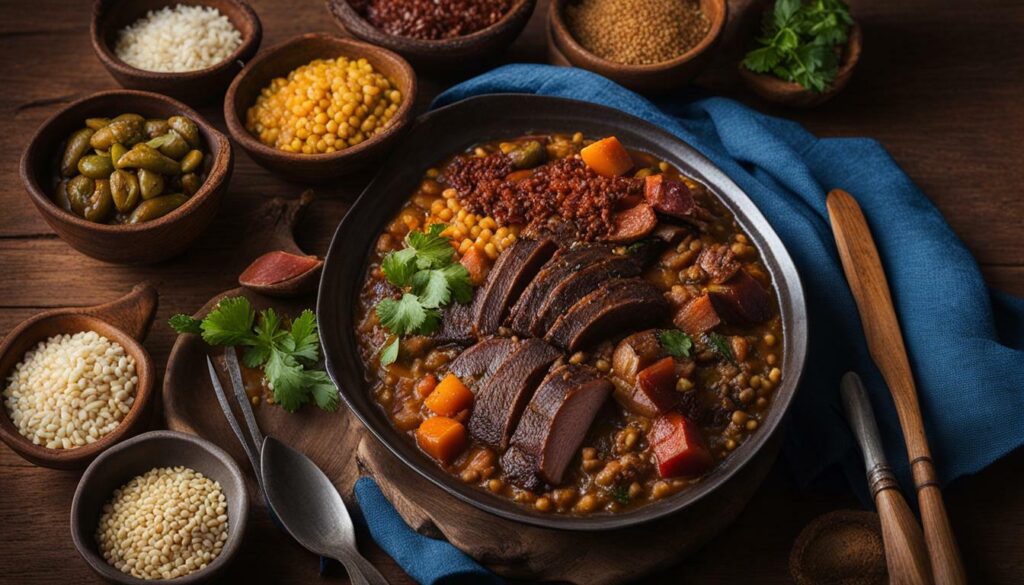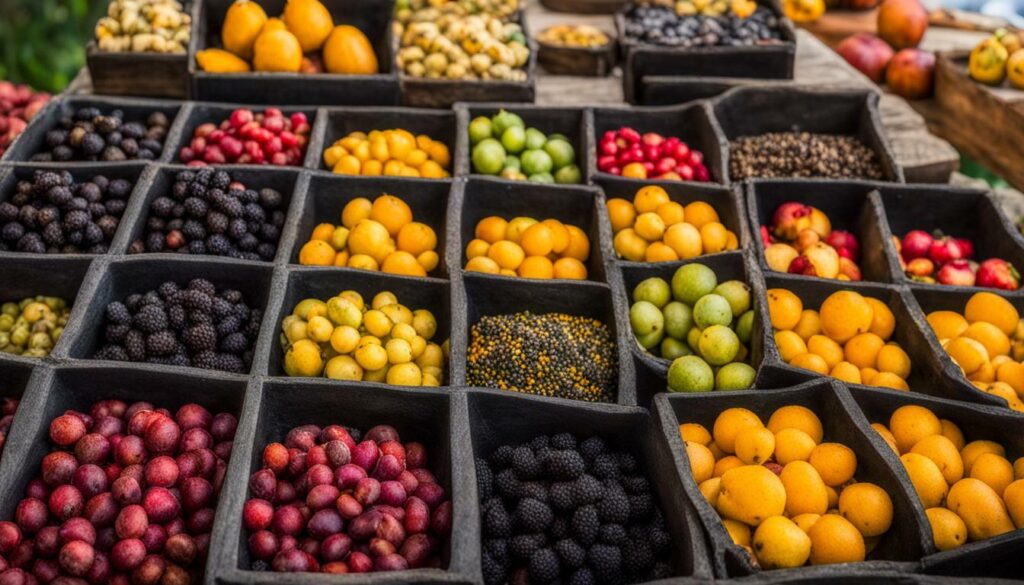The diets of the Botswana people have evolved over time, with traditional foods and national dishes shaping the culinary heritage of the country. Historically, the Botswana people primarily consumed meat and maize meal, with limited vegetable intake. Traditional dishes such as Mopane, made from dried caterpillars, and Seswaa, a beef stew, have been an integral part of Botswana’s food culture. Street food, including popular snacks like fried dough known as magwinya, is also widely enjoyed.
Key Takeaways:
- The traditional food pattern in Botswana, characterized by high carbohydrate intake, has been associated with a higher risk of obesity.
- Efforts are being made to improve food diversity and increase the consumption of vegetables, fruits, meat, and milk.
- Nutrition education programs and interventions are needed to address the dietary patterns and nutritional needs of the Botswana people.
- The elderly population in Botswana requires tailored approaches to promote healthier eating habits and improve food diversity.
- Further research is needed to understand other factors contributing to obesity rates in Botswana.
Traditional Botswana Foods
Traditional Botswana foods play a significant role in the country’s culinary traditions, with dishes like Mopane and Seswaa being staples in the diet. Mopane, made from dried caterpillars, is a protein-rich delicacy that has been enjoyed for centuries. It is often cooked with tomatoes, onions, and spices, creating a flavorful and nutritious dish. Seswaa, on the other hand, is a slow-cooked beef stew that is typically prepared for special occasions or gatherings. The meat is tender and succulent, making it a favourite among locals.
Aside from Mopane and Seswaa, there are several other traditional dishes that showcase Botswana’s rich food culture. Phaleche is a thick porridge made from sorghum or maize meal, often served with a variety of vegetables or meat. Bogobe is another popular porridge dish, usually made from sorghum or maize meal and served with milk or meat. These dishes provide sustenance and are deeply rooted in Botswana’s history and heritage.
Botswana’s traditional foods are not only delicious but also reflect the country’s natural resources and agricultural practices. The use of indigenous ingredients, such as caterpillars and locally sourced meats, highlights the importance of sustainable food systems and the preservation of traditional knowledge.
| Dish | Description | Ingredients |
|---|---|---|
| Mopane | A protein-rich delicacy made from dried caterpillars. | Caterpillars, tomatoes, onions, spices |
| Seswaa | A slow-cooked beef stew, tender and succulent. | Beef, onions, salt, water |
| Phaleche | A thick porridge made from sorghum or maize meal. | Sorghum or maize meal, water, vegetables or meat |
| Bogobe | A porridge dish made from sorghum or maize meal, often served with milk or meat. | Sorghum or maize meal, water, milk or meat |
Street Food in Botswana
Street food is a vibrant and popular aspect of Botswana’s cuisine, with dishes like magwinya offering a tasty and convenient option for locals and visitors alike. Botswana’s street food scene reflects the country’s diverse culinary heritage and is a testament to the rich flavours and cultural traditions of its people.
Magwinya, also known as fat cakes, is a beloved street food staple in Botswana. These deep-fried dough balls are light and fluffy on the inside, with a crispy exterior. They are often filled with a variety of savoury or sweet fillings, such as polony (a type of sausage), cheese, or jam. Magwinya is commonly enjoyed as a quick breakfast or snack on the go.
In addition to magwinya, Botswana’s street food offerings include a range of grilled meats, such as boerewors (a type of sausage) and sosaties (marinated skewered meat). These flavorful dishes are often served with pap, a thick maize porridge, and a side of chakalaka, a spicy vegetable relish. Other popular street food items include fried fish and chips, vetkoek (a deep-fried bread), and braaied (barbecued) chicken.
Exploring Botswana’s street food is not only a culinary adventure but also an opportunity to connect with the local culture and experience the vibrant atmosphere of bustling markets and roadside vendors. Whether you’re a food enthusiast or simply looking for a quick and delicious meal, Botswana’s street food scene is sure to satisfy your cravings and leave you craving for more.

“Botswana’s street food scene reflects the country’s diverse culinary heritage and is a testament to the rich flavors and cultural traditions of its people.”
Street Food in Botswana: A Flavorful Journey
When exploring Botswana’s street food offerings, it’s impossible to ignore the mouthwatering aromas and tempting displays that await around every corner. From savoury snacks to hearty meals, street food vendors in Botswana serve up a diverse array of dishes that are deeply rooted in the country’s cultural traditions.
| Popular Foods of Botswana | Famous Foods in Botswana | Botswana Food Dishes |
|---|---|---|
| Magwinya (Fat cakes) | Mopane | Seswaa |
| Boerewors (Sausages) | Chakalaka | Vetkoek |
| Sosaties (Skewered meat) | Pap (Maize porridge) | Braaied chicken |
Whether you’re wandering through the bustling streets of Gaborone or exploring the vibrant markets of Maun, you’ll find street food vendors serving up these iconic dishes and more. Botswana’s street food not only tantalizes the taste buds but also provides a glimpse into the country’s culinary heritage.
So, next time you find yourself in Botswana, don’t miss the opportunity to indulge in the flavours of the street. From the crispy goodness of magwinya to the succulent meats and vibrant flavours of traditional dishes, Botswana’s street food scene is a must-try for any food lover.
Health Implications of Traditional Diets
While traditional Botswana foods hold cultural significance, there are health implications associated with the high carbohydrate intake and limited dietary variety. Historically, the diets of the Botswana people have been centred around maize meal and meat, with a lack of vegetables. Traditional dishes such as Mopane, made from dried caterpillars, and Seswaa, a beef stew, are rich in carbohydrates and proteins but lack the necessary balance of nutrients.
Recent studies have identified a higher risk of obesity associated with the traditional food pattern in Botswana. The high intake of carbohydrates, particularly from maize meal, can lead to weight gain and other health issues. This is further exacerbated by the limited availability and consumption of vegetables, fruits, and other nutrient-dense foods.
To address these health concerns, it is crucial to promote dietary diversity and educate the Botswana people about the importance of a balanced diet. Efforts should be made to increase the intake of vegetables, fruits, meat, and milk, which can provide essential vitamins, minerals, and protein. By incorporating these foods into their diets, individuals can improve their overall nutrition and reduce the risk of obesity and related health problems.

Nutritional Needs of the Elderly
The elderly population in Botswana has specific nutritional needs that must be addressed. With limited dietary variety, many elderly individuals may not be receiving the necessary nutrients for optimal health. It is crucial to improve food diversity and increase the consumption of vegetables, fruits, meat, and milk among the elderly. These foods provide essential vitamins, minerals, and proteins that can support healthy ageing and prevent nutrient deficiencies.
Efforts to Improve Food Diversity
Recognizing the importance of improving food diversity in Botswana, various initiatives have been implemented. These include promoting the consumption of vegetables, fruits, meat, and milk, especially during festive occasions. By incorporating a wider range of foods into the diet, individuals can improve their overall nutrition and reduce the risk of nutrient deficiencies and associated health problems.
Nutritional Needs of the Elderly
Addressing the nutritional needs of the elderly population in Botswana is crucial, with efforts necessary to enhance food diversity and promote a balanced diet. The diets of the Botswana people have historically consisted mainly of meat and maize meal, with few vegetables. This limited dietary variety can result in nutrient deficiencies, which can have adverse effects on the health and well-being of older individuals.
In order to improve the nutritional status of the elderly in Botswana, it is important to increase the consumption of vegetables, fruits, meat, and milk. These food groups provide essential vitamins, minerals, and other nutrients that support overall health and vitality. Encouraging the inclusion of a variety of foods in the diet can help prevent malnutrition and age-related diseases.
Efforts should also be made to educate the elderly population about the importance of a balanced diet and the nutritional value of different foods. Nutrition education programs and interventions can play a crucial role in raising awareness and empowering individuals to make healthier food choices. By promoting the benefits of a diverse diet and providing practical tips on meal planning and preparation, older individuals can adopt sustainable eating habits that support their well-being.
The Role of Nutrition Education
Nutrition education programs can help to bridge the knowledge gap among the elderly population in Botswana. By providing information on the nutritional needs of older individuals, these programs can empower individuals to make informed choices about their diet. It is important to emphasize the importance of consuming a variety of foods to ensure a well-rounded nutrient intake.

A balanced diet for the elderly in Botswana should include a variety of foods such as fruits, vegetables, whole grains, lean proteins, and low-fat dairy products. These food groups provide essential nutrients such as vitamins, minerals, and fibre that support healthy ageing. Additionally, it is important to stay hydrated by drinking an adequate amount of water throughout the day.
By promoting nutrition education and enhancing food diversity, Botswana can improve the overall health and well-being of its elderly population. Sustainable interventions and tailored approaches are needed to address the unique challenges faced by older individuals and ensure that they have access to a nutritious and varied diet.
Obesity and Other Contributing Factors
While the traditional food pattern has been associated with a higher risk of obesity, other factors in Botswana’s food landscape require examination. The diets of the Botswana people have historically consisted mainly of meat and maize meal, with few vegetables. Traditional dishes, such as Mopane made from dried caterpillars and Seswaa, a beef stew, have been staples in Botswana cuisine. Street food, including popular snacks like magwinya, and fried dough, is also widely consumed.
Recent studies have highlighted the health implications of the traditional food pattern, characterized by a high carbohydrate intake. The limited dietary variety, with tea, sorghum, and maize meal being the most commonly consumed foods, has contributed to nutritional imbalances. The impact of this diet pattern on obesity rates is a significant concern.
However, it is essential to consider other factors contributing to obesity in Botswana. Environmental factors, such as accessibility to unhealthy food options, sedentary lifestyles, and lack of nutrition education, play a crucial role in shaping dietary habits and overall health. Understanding these factors is key to developing targeted interventions and promoting healthier eating habits in the country.
| Contributing Factors to Obesity in Botswana |
|---|
| Traditional food pattern |
| Limited dietary variety |
| Environmental factors |
| Sedentary lifestyles |
| Lack of nutrition education |
“Addressing the complex issue of obesity requires a multi-faceted approach.”
The current focus on dietary diversity, nutrition education, and sustainable interventions is crucial for combating obesity in Botswana. By promoting a wider range of vegetables, fruits, meat, and milk consumption, individuals can benefit from a more balanced and nutrient-rich diet. Nutrition education programs and interventions can play a significant role in raising awareness about the nutritional value of different foods and encouraging healthier eating habits.

Efforts to improve food diversity and increase access to nutritious food options should be complemented by initiatives that address environmental factors and promote physical activity. Creating environments that support active lifestyles and providing opportunities for regular exercise can help reduce the risk of obesity and related chronic diseases.
Overall, addressing the complex issue of obesity in Botswana requires a comprehensive and collaborative approach. By understanding and addressing the contributing factors beyond the traditional food pattern, the country can work towards a healthier future for its population.
The Importance of Nutrition Education
Nutrition education programs play a vital role in addressing the dietary patterns and nutritional needs of the Botswana people. With the historical emphasis on meat and maize meal in their diets, there has been limited consumption of vegetables, leading to a lack of dietary variety. It is essential to educate the population about the importance of including a wide range of food groups, such as vegetables, fruits, meat, and milk, to achieve balanced nutrition.
Through nutrition education, individuals can learn about the nutritional value of different foods and the benefits they provide. This knowledge enables them to make informed decisions when it comes to their dietary choices. By promoting healthier eating habits, nutrition education programs can help combat the high carbohydrate intake associated with traditional diets and reduce the risk of obesity in Botswana.
Furthermore, nutrition education can emphasize the significance of food diversity, especially among the elderly population. As they are more prone to nutrient deficiencies, it becomes crucial to increase their consumption of essential vitamins, minerals, and other nutrients. Encouraging the inclusion of diverse foods in their meals can help meet their nutritional needs and support their overall health and well-being.
Enhancing the Nutrition Knowledge of Botswana:
- Providing educational sessions on the benefits of a diverse diet, highlighting the importance of vegetables, fruits, meat, and milk.
- Offering practical cooking demonstrations that showcase ways to incorporate a variety of foods in traditional recipes.
- Collaborating with local communities and healthcare professionals to develop culturally sensitive nutrition education materials.
- Promoting nutrition education in schools and other community settings to instil healthy eating habits from an early age.
Nutrition education is a fundamental step towards improving the overall health and well-being of the Botswana people. By empowering individuals with knowledge and skills related to nutrition, they can make informed choices that support their long-term health goals. It is essential to continue investing in nutrition education programs and interventions to create a healthier future for Botswana.

Efforts to Improve Food Diversity
In order to enhance food diversity, it is essential to incorporate a wider range of ingredients, including vegetables, fruits, meat, and milk, into the Botswana diet. The current dietary pattern in Botswana is characterized by a heavy reliance on staple foods such as tea, sorghum, and maize meal, which are high in carbohydrates but low in essential nutrients. To address this issue, initiatives have been launched to promote the consumption of a variety of foods and encourage the inclusion of traditional and nutritious ingredients in daily meals.
One approach is to raise awareness about the nutritional value and health benefits of traditional Botswana foods. By highlighting the cultural significance and culinary heritage of these dishes, individuals can develop a greater appreciation for their traditional cuisine and be motivated to incorporate them into their meals. Additionally, efforts are being made to introduce innovative variations of traditional dishes that appeal to younger generations, thus bridging the gap between traditional and contemporary food preferences.
Nutrition education programs play a crucial role in promoting healthier eating habits and empowering individuals to make informed food choices. These programs aim to educate the public about the importance of balanced nutrition, portion control, and the benefits of consuming a diverse range of foods. By providing practical tips, recipes, and cooking demonstrations, nutrition education programs help individuals develop the necessary skills to prepare nutritious and culturally diverse meals.
| Benefits of Improving Food Diversity | Efforts to Promote Food Diversity |
|---|---|
|
|
Efforts to improve food diversity in Botswana extend beyond individual interventions. Collaborative efforts involving government agencies, non-profit organizations, and local communities are essential to create a supportive environment that encourages the cultivation, preservation, and consumption of traditional foods. By recognizing the cultural and economic value of traditional cuisine, these initiatives not only address the nutritional needs of the population but also contribute to the preservation of Botswana’s rich culinary heritage.

Tradition Meets Innovation
“We are bridging the gap between tradition and innovation by introducing new cooking techniques and flavors without compromising the authenticity of our traditional dishes.” – Chef Tshepo Molefe
One key aspect of promoting food diversity is the incorporation of traditional ingredients and flavours into contemporary culinary practices. This blending of tradition and innovation not only introduces new and exciting tastes but also helps to revitalize the image of traditional foods, making them more accessible and appealing to a wider audience. By embracing these innovations, Botswana’s culinary scene can continue to evolve while honouring its cultural roots.
As Botswana strives to address the dietary patterns and nutritional needs of its population, efforts to improve food diversity are crucial. By incorporating a wider range of ingredients, promoting traditional dishes, and providing nutrition education, Botswana can create a healthier and more vibrant food culture for its people.
Future Recommendations
Moving forward, it is crucial to implement sustainable interventions and tailored approaches to meet the dietary and nutritional needs of the Botswana population. One key recommendation is to prioritize nutrition education programs that promote healthy eating habits and raise awareness about the nutritional value of different foods. By educating individuals about the benefits of a diverse diet and the importance of consuming vegetables, fruits, meat, and milk, we can help improve overall nutrition and reduce the risk of diet-related health issues.
Efforts should also be made to improve food diversity in Botswana. Encouraging the consumption of a wider range of foods, particularly during festive occasions, can help address the limited dietary variety commonly observed. By incorporating more vegetables, fruits, meat, and milk into traditional meals, we can ensure that individuals receive a greater array of essential nutrients.
Furthermore, it is essential to consider the nutritional needs of the elderly population in Botswana. As they age, older adults require specific nutrients to maintain optimal health. By focusing on increasing their intake of vegetables, fruits, meat, and milk, we can support the nutritional requirements of this vulnerable group. Additionally, nutrition interventions should aim to improve food diversity and promote the consumption of nutrient-rich foods to enhance overall well-being.
| Botswana Traditional Foods | Botswana Cuisine | Botswana Meals |
|---|---|---|
| Mopane | Maize Meal | Sorghum |
| Seswaa | Tea | Maize-Meal |
| Magwinya |
“Improving the dietary patterns and nutritional status of the Botswana people requires a multi-faceted approach. We must address the limited food diversity, increase the consumption of essential food groups, and provide education on nutrition. By implementing sustainable interventions tailored to the specific needs of the population, we can pave the way for healthier eating habits and improved overall well-being.” – Nutrition Expert
Summary
- Implement sustainable interventions and tailored approaches to meet the dietary and nutritional needs of the Botswana population.
- Prioritize nutrition education programs to promote healthy eating habits and raise awareness about the nutritional value of different foods.
- Improve food diversity by encouraging the consumption of a wider range of vegetables, fruits, meat, and milk.
- Address the nutritional needs of the elderly population through increased intake of essential food groups.

Conclusion
The past and present diets of Botswana provide valuable insights into the cultural and nutritional landscape of the country, calling for continued research and interventions to address dietary patterns and promote healthier eating habits.
Historically, the diets of the Botswana people have been centred around meat and maize meal, with a limited consumption of vegetables. Traditional dishes like Mopane, made from dried caterpillars, and Seswaa, a beef stew, have been staples in the Botswana cuisine. Street food, such as the popular fried dough called magwinya, also plays a significant role in the local culinary scene.
However, recent studies have highlighted that the traditional food pattern, characterized by a high intake of carbohydrates, may contribute to a higher risk of obesity. While the traditional diet remains prevalent, it is essential to explore other factors contributing to the obesity rates in Botswana. Further research is needed to gain a comprehensive understanding of the issue.
Efforts to improve food diversity in Botswana are crucial, particularly among the elderly population. With tea, sorghum, and maize meal being the most commonly consumed foods, it is vital to increase the consumption of vegetables, fruits, meat, and milk to meet the nutritional needs of the elderly. Additionally, nutrition education programs and interventions are necessary to promote healthy eating habits and raise awareness about the nutritional value of different foods.
In conclusion, the past and present diets of Botswana reflect cultural traditions and dietary patterns that warrant attention and intervention. By addressing these patterns and promoting healthier eating habits, Botswana can strive towards a more diverse and balanced diet, improving the overall health and well-being of its people.
FAQ
What are some traditional foods in Botswana?
Traditional dishes in Botswana include Mopane, which is made from dried caterpillars, and Seswaa, a beef stew.
What is a popular street food in Botswana?
One popular street food in Botswana is magwinya, which is fried dough.
Are traditional diets in Botswana associated with health risks?
Recent studies have found that the traditional food pattern, characterized by high carbohydrate intake, is associated with a higher risk of obesity.
What are the most commonly consumed foods in Botswana?
The most commonly consumed foods in Botswana are tea, sorghum, and maize-meal.
What dietary improvements are recommended for the elderly population in Botswana?
It is recommended to improve food diversity and increase vegetable, fruit, meat, and milk intake among the elderly population in Botswana.
What factors contribute to obesity in Botswana?
The traditional food pattern is one factor, but more research is needed to understand other factors contributing to obesity in Botswana.
Why is nutrition education important in Botswana?
Nutrition education programs and interventions are crucial in Botswana to address the dietary patterns and nutritional needs of the population.
What efforts are being made to improve food diversity in Botswana?
Efforts are being made to include more vegetables, fruits, meat, and milk in the diet, especially during festive occasions in Botswana.
What are the future recommendations for addressing dietary patterns in Botswana?
Future recommendations include sustainable interventions and tailored approaches to promote healthier eating habits in Botswana.
Source Links
- https://www.hindawi.com/journals/jobe/2020/4959272/
- https://www.sciencedirect.com/science/article/abs/pii/S1499404607008482
- https://www.ciee.org/go-abroad/college-study-abroad/blog/what-eat-botswana



